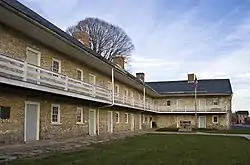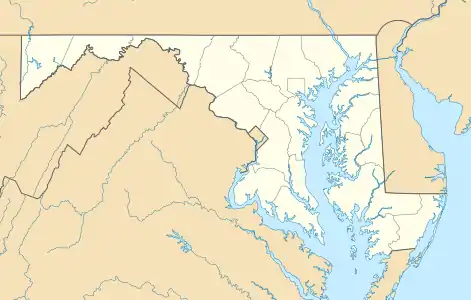Maryland School for the Deaf
The Maryland School for the Deaf is a school that provides free public education to deaf and hard-of-hearing Maryland residents, from birth to age 21. Maryland School for the Deaf have two different campuses. One campus is located in Columbia, Maryland and the second location is located in Frederick, Maryland.
| Maryland School for the Deaf | |
|---|---|
 A snapshot of Ely Building and a new cafeteria in background. | |
| Location | |

| |
| , United States | |
| Coordinates | 39°24′31″N 77°24′38″W |
| Information | |
| Former name | Maryland Institute for the Education of the Deaf and Dumb |
| Type | Public |
| Established | September 1868 |
| Superintendent | James E. Tucker |
| Faculty | 100+ |
| Grades | K-12 |
| Number of students | 500+ |
| International students | 2 |
| Language | American Sign Language, English |
| Color(s) | Orange and Black |
| Athletics conference | Eastern Schools for the Deaf Athletic Association, Maryland Independent Athletic Conference |
| Mascot | Orioles |
| Publication | The Maryland Bulletin |
| Alumni | Nyle DiMarco |
| Website | http://www.msd.edu |
Hessian Barracks | |
 Hessian Barracks at the Maryland School for the Deaf | |
 | |
| Location | 242 S. Market St., Frederick, Maryland |
| Coordinates | 39°24′32.6″N 77°24′34.6″W |
| Area | 4 acres (1.6 ha) |
| Built | 1780 |
| NRHP reference No. | 71000373[1] |
| Added to NRHP | January 25, 1971 |
History
The school was established at Frederick, Maryland in 1868 (Chapter 247, Acts of 1867; Chapter 409, Acts of 1868). The original buildings for the school were the Hessian Barracks, used during the Revolutionary War to detain Hessian mercenaries who were hired by the British. The buildings were used by Lewis and Clark to store supplies before their famous expedition began.[2]
Philosophy
At the Frederick campus, the School offers both academic and life-based education leading to a Maryland high school diploma or a Maryland School for the Deaf diploma. In English and American Sign Language (ASL), the school teaches communications skills, including speech and speech reading, fingerspelling, and auditory training, and the use of individual hearing aids. It also offers a broad athletic and physical education program, as well as social and recreational activities.
Maryland School for the Deaf's High School offers several Advanced Placement classes as well as Honors courses, which are taught in American Sign Language. Students take a variety of classes, including American Government, History, Spanish, English, Biology, Algebra, and Chemistry, as well as a variety of elective courses. In 2007, MSD students passed the state exams (High School Assessments) at a higher rate than their hearing counterparts. Students work on many academic skills at MSD, such as English and ASL grammar, reading strategies, and high level math and science. MSD is a competitor in the Academic Bowl and were the 2008, 2010, 2011, 2012 Regional Champions. They also compete in various math and science competitions and generally place in the top five.
Residency
Maryland School for the Deaf is also a residential school. It has dormitories where students reside throughout the week. Students arrive on Monday and depart on Fridays. The dormitories are for students who live far enough not to be able to travel by bus every day to school. There are dormitories for male and female students in high school. Maryland School for the Deaf's residential programs offer after-school program (ASP) activities.
Athletics
Sports are immensely popular as an after-school activity. Both campuses have athletic fields and regulation sized basketball and volleyball courts. One of the building has an indoor swimming pool.
Middle and high school students participate in organized leagues and compete against public schools, private schools, and schools for deaf and hard of hearing students. MSD teams compete in national tournaments in various sports. MSD students are frequent competitors in the Deaflympics, and MSD coaches are often invited to coach the US teams. Current MSD sports include:
- Baseball
- Basketball
- Cheerleading
- Cross Country
- Football
- Powerlifting
- Soccer (elementary only)
- Softball
- Track and field
- Volleyball
- Wrestling
| Sports | National Deaf Prep Championships |
|---|---|
| Academic Bowl | 2005, 2010, 2011, 2012, 2013 |
| Boys Cross Country | 1986 |
| Girls Cross Country | 1986, 1988, 1989, 1990, 1991, 1992 |
| Football | 2001, 2003, 2004, 2005, 2006, 2007, 2008, 2009, 2010, 2011, 2014, 2015, 2016, 2017, 2018 |
| Volleyball | 2001, 2003, 2004, 2006, 2007, 2008, 2009, 2010, 2013, 2014, 2015, 2018 |
| Boys Basketball | 1993, 1994, 2007, 2010, 2011, 2015, 2016, 2018, 2019, 2020 |
| Girls Basketball | 2001, 2002, 2003, 2004, 2008, 2010, 2014, 2015, 2016, 2017 |
| Wrestling | 1987, 1988, 1995, 1996, 1997, 1998, 1999, 2000, 2002, 2005, 2010, 2011 |
| Soccer | 1937 |
| Baseball | 2005, 2016, 2017, 2018, 2019 |
| Softball | 2008, 2010, 2011, 2015, 2019 |
| Boys Track & Field | 1986, 1987, 2017, 2019 |
| Girls Track & Field | 1985, 1988, 2002, 2003, 2015, 2016, 2017, 2019 |
Frederick
Established in 1868, the Frederick Campus of the Maryland School for the Deaf enrolls deaf and hard-of-hearing students in pre-kindergarten through grade 12 (Chapter 247, Acts of 1867; Chapter 409, Acts of 1868). For young children (from birth to age five) and their families, the campus also provides language skill development.
At the Frederick campus, about thirty percent of enrolled students live on campus weeknights during the school year (late August through early June). Residential halls are staffed by student life counselors who supervise students and coordinate after-school programming, such as intramural games, field trips, swimming, and hiking.
Checkers, a 1950s style diner located on the Frederick campus, is student staffed and gives middle and high school students a place to meet friends, watch movies, buy snacks, and play pool and foosball. Checkers is decorated mainly with red, black and white colors relating to the game of checkers and 1950s diner colors. Checkers' sparkly red booths give it a 1950s feel. The snack bar offers sweets, chips and drinks. It also provides hot foods such as french fries, hot dogs, and mozzarella cheese sticks. Students also have the opportunity to gain experience by working at Checkers as a cashier or cook.
The Maryland State High School diploma or the Maryland School for the Deaf diploma is awarded to each graduating senior, and many graduates pursue higher education degrees. Vocational or technical training, and vocational rehabilitation services are available to help other graduates secure employment.
- Ely Building (1972–present): middle school and high school grades 6-12
- Veditz Building (1974–present): CTE, Study Work and LBE High School
- New elementary building (2009–present): grades Toddler-5
- New cafeteria (2011–present)
Columbia
The Columbia campus of the Maryland School for the Deaf is located on a subdivision of the Otten Slave Farm Property in the former Pfeffer's Corner neighborhood. George Herman Otten combined a 91-acre parcel bought in 1853 with a 132-acre parcel, forming the Otten Farm. In 1935 his estate willed the farm to the regents of the University of Maryland. It became an agricultural research center, and later the "Horse Farm," researching race horse breeds. In 1979, a historical survey considered the property a significant historical resource, but a 25-page 1992 update considered the site not worth preservation, considering the university could move operations elsewhere. The property has been subdivided by government projects to the point where it is not recognizable as the original farm. Parcels were sold the state for the Route 100 project, and to the county for Waterloo Elementary. The remaining 68 acres were sold by the University to the Maryland State Department of Health and Mental Hygiene in 1968 to build the School for the Deaf campus, with 60 acres remaining for the university.[3][4][5]
The school opened in September 1973. It serves 120 students with a 2015 budget of approximately $10 million and a staff of 109.5.[6][7]
Notable alumni
- George W. Veditz (1878), Founded Maryland School for the Deaf Alumni Association, President of National Association of the Deaf, Preservation of the Sign Language
- Leah Katz-Hernandez (2005), first deaf Receptionist of the United States (ROTUS) in the White House for President Barack Obama
- Nyle DiMarco (2007), model, actor, winner of reality television shows (America's Next Top Model and Dancing with the Stars)
References
- "National Register Information System". National Register of Historic Places. National Park Service. July 9, 2010.
- Gannon, Jack. 1981. Deaf Heritage–A Narrative History of Deaf America, Silver Spring, MD: National Association of the Deaf, page 38 (illustration) and page 39 (PDF Archived 2012-03-28 at the Wayback Machine)(PDF Archived 2012-03-28 at the Wayback Machine)
- "HO-549 Otten Farm" (PDF). 16 August 2014.
- Howard's Roads to the Past. Howard County Sesquicentennial Celebration Committee, 2001. 2001. p. 9.
- California. San Fernando Valley State College, Los Angeles. Dept. of Special and Rehabilitative Education, San Fernando Valley State College. Dept. of Special and Rehabilitative Education U.S. Dept. of Health, Education, and Welfare, Rehabilitation Services Administration (1973). Operation TRIPOD: Toward Rehabilitation Involvement by Parents Of the Deaf: A workshop sponsored by the Dept. of Special and Rehabilitative Education, San Fernando Valley State College, Northridge, Calif. Memphis, Tenn., Apr. 21-24, 1971. p. 38.CS1 maint: multiple names: authors list (link)
- Lynh Bui & David Marino-Nachison (6 December 2012). "Aide at Maryland School for the Deaf charged with sex abuse of minors". The Washington Post.
- "Maryland State Archives". Retrieved 16 August 2014.
External links
| Wikimedia Commons has media related to Maryland School for the Deaf. |